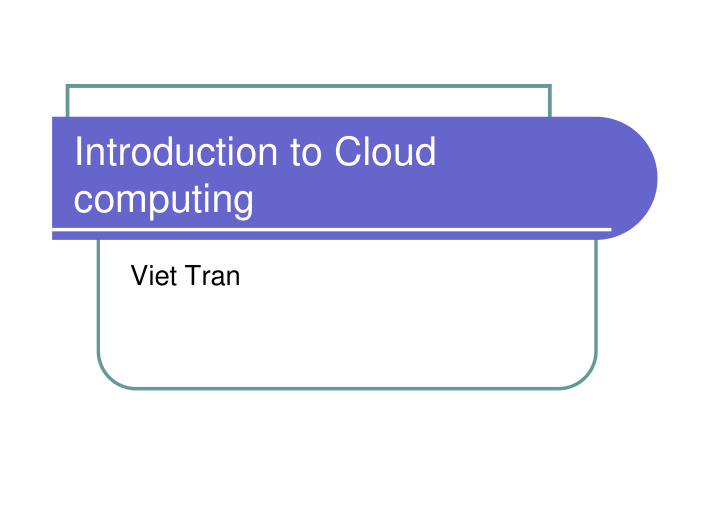



Introduction to Cloud computing Viet Tran
Type of Cloud computing � Infrastructure as a Service IaaS: offer full virtual machines via hardware virtualization tech. � Amazon EC2, AbiCloud, ElasticHosts,… � Platform as a Service PaaS: offer platforms (e.g. API) where users can deploy services where users can deploy services � Amazon SQS, Microsoft Azure, Google App Engine, LAMP � Can be realized as IaaS+Platform (API) � But can be also realized without hardware virtualization (e.g. separation via user account or sandboxing) � Software as a Service: offer cloud/web applications � Amazon RDS, Google Docs, …
Type of Cloud computing � Public clouds � Sell/buy services � Amazon, AbiCloud, ElasticHosts, … � Limited customization, complex user management � Private clouds � Private clouds � Internal use inside organization � VMWare VSphere, IBM Websphere cloud, Sun cloud � More like advanced or automatized virtual infrastructure � Wide customization, simple user management
Infrastructure as a Service � IaaS = Virtualization + Standardization + Automation � Can be considered as automation tool over virtualization software (Xen, KVM, VMWare) � Nearly every large software/hardware vendor offer some middleware for IaaS (for public or private cloud) � IBM Websphere cloud, VMWare Vsphere, Sun Cloud, …. � Opensource cloud middleware: Eucalyptus, OpenNebula, Nimbus � All support Amazon EC2 client beside native client
Amazon EC2 � Leader of IaaS, practically standard � Running on XEN/Linux � Using EC2: � Register, get certificate, install EC2 client Register, get certificate, install EC2 client � Creating own image if needed and upload � Run VM instances � Use VM instances
Creating images of VM � Amazon offer wide range of ready-to-use images (major Linux distributions + basic software) � They are XEN images with some strict configuration (user name, partitions) � Users should download the provided images and � Users should download the provided images and install their own software if needed � Build images from scratch is not recommended because lack of documentations � Just simply download Xen images from Amazon, mount as loopback disk on local machine and copy software (or run the images in Xen)
Upload and register images � ec2-upload-bundle images � ec2-register � There are usually 3 files for a VM: kernel, ramdisk and disk images ramdisk and disk images � The images are stored in Amazon S3 service (splited to many small files), and accessible via ID (returned from rec2- register)
Run instances � ec2-run-instances imageID -k mykey -t c1.medium � mykey: SSH key for login (login via password is not allowed) � c1.medium: type of virtual machine (CPU, RAM, …) � c1.medium: type of virtual machine (CPU, RAM, …) � Return instance ID � ec2-describe-instances instanceID � Return status of instance and IP/hostname � Just use SSH with private key to login to the creatd instance
Graphical interface: ElasticFox � Plugin to Firefox
Notes � EC2 does not save images after termination of instances � All modification (i.e. data created or software installed during running) will be lost if not save elsewhere � Use S3 or EBS to save data permanently � Each instance has public (assigned) and private (real) IP � User connect to the instance via public IP � SNAT/DNAT used for translation to private IP � Can be integrate with company private network via VPN
Open source cloud middleware � Eucalyptus � OpenNebula � Nimbus � All support EC2 client � OpenNebula and Nimbus have their own native clients
Eucalyptus � Most close to EC2 � Support XEN and KVM � Support elastic IP � Excellent interface for user management and system configuration system configuration � Very limited possibility for customization � Excellent user docs, nearly no developer docs => Suitable for building public cloud
OpenNebula � More close to virtual infrastructure � Support XEN, KVM, VMWare (VirtualBox planned) � No elastic IP, clumsy IP assignment � Wide range of customization, e.g. store images after termination, easily to add new function after termination, easily to add new function � Good develop. docs => Suitable for build private clouds
Nimbus � Interface via Globus Toolkit 4 � Difficult to install (need to know about GT4), confusing docs � Support cluster deployment at single � Support cluster deployment at single command � No elastic IP => Suitable for build on or integrate with grid infrastructure
Advanced cloud services at AWS Compute Monitoring � � Amazon Elastic Compute Amazon CloudWatch � � Cloud (EC2) � Networking Amazon Elastic MapReduce Amazon Virtual Private Cloud (VPC) � � Auto Scaling Elastic Load Balancing � � Content Delivery � � Payments & Billing Amazon CloudFront Amazon Flexible Payments � � Service (FPS) � Database Amazon SimpleDB Amazon DevPay � � Amazon Relational Database Amazon Relational Database Storage Storage � � Service (RDS) Amazon Simple Storage Service (S3) � E-Commerce Amazon Elastic Block Storage (EBS) � � Amazon Fulfillment Web AWS Import/Export � � Service (FWS) � Support Messaging � AWS Premium Support � Amazon Simple Queue Service (SQS) � Web Traffic � Alexa Web Information Service � EC2 is only a small part of Alexa Top Sites � Workforce � Cloud computing Amazon Mechanical Turk �
Recommend
More recommend